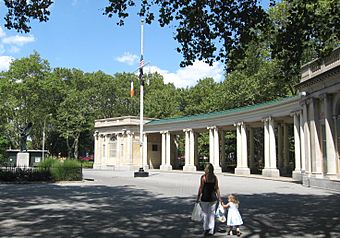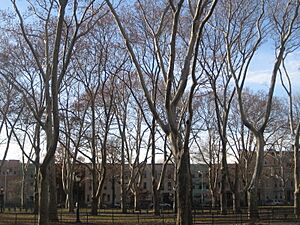McGolrick Park facts for kids
Quick facts for kids |
|
|
Monsignor McGolrick Park and Shelter Pavilion
|
|

Shelter Pavilion in late summer
|
|
| Location | Bounded by Nassau and Driggs Avenues, Russell and Monitor Streets, Brooklyn, New York |
|---|---|
| Area | 9.1 acres (3.7 ha) |
| Built | 1910 |
| Architect | Helmle & Huberty |
| Architectural style | French |
| NRHP reference No. | 80002633 |
| Added to NRHP | May 06, 1980 |
Monsignor McGolrick Park is a lovely green space in the Greenpoint, Brooklyn neighborhood of New York City. You can find it between Driggs Avenue, Russell Street, Nassau Avenue, and Monitor Street. It's a great place for people to relax and enjoy nature in the city.
Contents
Park History: How It Started
This park has an interesting past! The city bought the land for the park in 1889. The park officially opened just two years later, in 1891.
Original Name: Winthrop Park
When it first opened, the park was called Winthrop Park. It was named after a man named Col. Winthrop Jones. He was an assemblyman, which means he was a member of the state's law-making group. He also helped the city buy the land for the park. Interestingly, his father was the Parks Commissioner, who was in charge of all the city parks. Sadly, Jones passed away in 1890, soon after the park was created.
New Name: Monsignor McGolrick Park
In 1941, the park's name was changed to Monsignor McGolrick Park. This new name honored Monsignor Edward J. McGolrick (1857-1938). He was a respected religious leader and the longtime pastor of St. Cecilia's Roman Catholic Church, which was nearby. Since Winthrop Jones didn't have any children, there was no family in Greenpoint to object to the park being renamed.
Park Features: What You Can See
Monsignor McGolrick Park is home to some beautiful and historic structures and monuments.
The Shelter Pavilion
One of the main attractions is the classical brick and limestone Shelter Pavilion. It was built in 1910 by architects Helmle & Huberty. This beautiful building is very important! In 1966, it was named a New York City Landmark. This means it's a special building that the city wants to protect because of its history and design. Later, in 1980, it was also added to the National Register of Historic Places. This is a list of places across the country that are important to American history. The pavilion was repaired and made new again in 1985.
World War I Memorial
To the west of the pavilion, you'll find a bronze statue. It's a winged figure of victory, created by artist Carl Augustus Heber in 1923. This monument honors the 150 people from Greenpoint, Brooklyn, who fought in World War I. The statue shows a female figure, like a symbol, holding a laurel wreath, which means victory. In her other hand, she holds a large palm frond, which is a symbol of peace. The stone base of the monument has the names of battle locations in France carved into it. The Greenpoint Memorial Association paid $7,300 to have this important monument made.
The Monitor and the Merrimac Sculpture
Another interesting sculpture in the park is called The Monitor and the Merrimac. It was made by Antonio de Filippo. This artwork remembers a famous naval battle from the American Civil War, the Battle of the Monitor and Merrimack. The USS Monitor was a special ironclad ship. It was actually built very close to the park, at the Continental Iron Works in Greenpoint. It was then prepared for battle at the Brooklyn Navy Yard.






